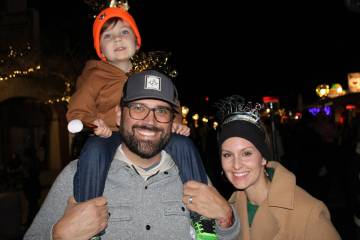OHV issue to go back to voters
It’s a topic that’s once again gaining momentum and debate within the city.
“Tonight I’m going to go over some research that we were asked to perform to provide information to council concerning off-highway vehicles and provide information for you to use to give us direction,” BCPD chief Tim Shea said as an introduction to a presentation on the use of off-highway vehicles (OHVs) on city streets. “The subjects that we were given to take a look at concerned some of the other communities that have OHVs that are permitted on the roadways, not only in this state but in adjacent states, what the current state laws are, what the city is permitted to do under those state laws, some of the complaints that we get now and some of the issues that we’re finding currently.”
In the end, the council kicked the can down the road, or maybe the trail in this case. They directed staff to work with OHV owners on what they wanted to see changed in the law and to put together yet another ballot question for the 2026 ballot.
But, even that is complicated. The proposed ballot question would have to come back before council in early 2026 for their approval of the language. But the council in 2026 may not be the same people who are there now. Fox is in a runoff in November against Denise Ashurst. If Ashurst wins, then it is basically a new council. And one council cannot, under state law, take any action that binds a future council.
A ballot question on this same issue was defeated in 2019, 56%-44%. However, that advisory-only question was very wide open, asking only, “Do you support the operation of Off Highway Vehicles (OHV) on city streets pursuant to NRS 490.100?”
Back in April, when the council last discussed the issue, Councilmember Steve Walton directly addressed that open-ended aspect of the 2019 question.
“The ballot question, to my recollection, was so vague that I couldn’t wrap my head around what it would be,” he said. “So, in order to avoid some type of result that would be undesirable, I’ll just vote ‘no.’ In my circle that was the consensus. There was no mechanism to ensure this would not be like ‘mosquitoes at a picnic’ where OHVs are all over our city streets.”
In April, Councilmember Matt Fox said that the people asking for the ability to use city streets want just two things.
“All we would really be doing is giving access to what people are already doing,” he said. “Going from their house to the desert and to the gas station is all that is being requested from the community.”
This is a contentious local issue. It is brought up all the time in public comment and, until recently, all of the comments railed against the idea saying that the question had been settled in 2019. Until recently.
At the April 23 meeting, in what was pretty obvious, an organized campaign of OHV enthusiasts had their say and the comments on the issue were about 10-1 in favor of allowing some kind of limited use of city roads for OHVs.
But the city may be limited in what it can allow by state law. Remember that a local law can be stricter than a state law but it cannot be less strict.
“Under the state law, the city is allowed to designate a portion of the roadway within the city for any off-highway use to access trails and the off-highway vehicles are limited to traveling two miles,” Shea explained. “A new section that was added by the Legislature in 2021 pertains to cities of 25,000 or less and it can designate certain roadways for large all-terrain vehicles to travel upon if the large all-terrain vehicle is properly registered and insured and has appropriate equipment and the operator has a valid driver’s license. Properly registered does not mean a license plate. It means that it has the appropriate sticker. It’s an off-road sticker which allows it to be used off-road and on-road for those roads within those jurisdictions that have permitted those roads to be used under this law. So they can’t be driven everywhere. They can only be driven on improved roadways when the local jurisdictions made that determination.”
Shea pointed out that no matter what safety equipment an OHV has, it cannot be made street-legal in Nevada per the Nevada Revised Statutes.
There are other restrictions under state law that makes this difficult. First, NRS prohibits the use of OHVs in undeveloped land within 1,000 feet of a developed residential area. Second, in 2008, the state tightened restrictions having to do with state-maintained roads. Prior to that time, only roads deemed “restricted” were off limits to OHVs. After 2008, that restriction was expanded to include all state-maintained roads.
Given that Boulder City Parkway (what old-timers still refer to as Nevada Highway) from its inception point off the flyover ramp of I-11 all the way to the entrance of Lake Mead Recreational Center is all state-maintained and prohibited for use by OHVs and further given that almost all of the gas stations in Boulder City are on or just adjacent to Boulder City Parkway, allowing use of city roads for the purpose of getting to and from a gas station becomes problematic. Also, it makes it all but impossible to get to desert areas north of town unless the OHV is already located north of Boulder City Parkway.
An issue brought up often is that golf carts are allowed anywhere in the city. Shea pointed out that, under state law, a golf cart is not an OHV and is not subject to the same restrictions.
Shea said there were three paths the city can take: 1) Maintain the current prohibition; 2) Allow OHVs to access city roads on a limited basis, allowing owners to use city streets only to get to certain designated trails or 3) To allow unrestricted access to city roads for OHVs as long as that does not run afoul of state law.
The chief reported that most people respond well to a verbal warning and that they often do not know they are breaking the law because they are from Arizona, California or Utah, all states that allow an OHV to be made street legal.
“A vehicle that is street-legal in Arizona is not street-legal in Nevada,” he said.
Shea also noted that the current law is difficult to enforce because it was written for a different time and for vehicle types that do not really exist anymore, which makes the law ambiguous. There is also the issue of response.
“By the time we get out there, they are usually long gone,” Shea said. “Or we can see them out in the desert but we can’t get out there with a patrol vehicle.”
Once Shea finished his presentation, it became clear very quickly that the council was divided.
Fox advocated allowing some use of city roads on a pilot basis for six months to see if it would work. Councilmember Cokie Booth said she wanted to see all city streets opened up to OHVs, partially as a way to bring additional customers to struggling local businesses. Newly re-elected mayor pro tempore Sherri Jorgensen sided with the people saying that the issue had been decided in 2019 and said she could not vote to change anything unless the issue went back on the ballot in a form more clear than the 2019 advisory vote.
Although he had stated back in April that many people who voted in 2019 had no idea what they were voting on, Walton agreed with Jorgensen that he could not vote to do something in direct opposition to an already-decided advisory vote.
Mayor Joe Hardy, a doctor, was laser-focused on the issue of safety.
“For lack of a better way of saying it, if somebody who gets in an accident with one of these they will be on the losing end of any collision,” he said.
















